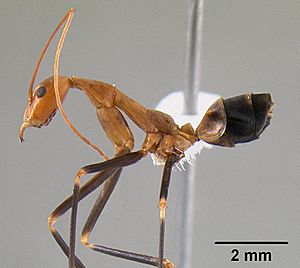Leptomyrmex facts for kids
Quick facts for kids Leptomyrmex |
|
|---|---|
 |
|
| L. darlingtoni worker from Australia | |
| Scientific classification |
|
| Kingdom: | Animalia |
| Phylum: | Arthropoda |
| Class: | Insecta |
| Order: | Hymenoptera |
| Family: | Formicidae |
| Subfamily: | Dolichoderinae |
| Tribe: | Leptomyrmecini |
| Genus: | Leptomyrmex Mayr, 1862 |
| Type species | |
| Formica erythrocephala |
|
| Diversity | |
| 28 species | |
Leptomyrmex, also known as spider ants, are a special type of ant. They belong to a group of ants called Dolichoderinae. They get their nickname, 'spider ants,' because of their long legs and the way they move, which looks a bit like a spider. These ants are usually orange and black.
You can find spider ants living in wet forests and sclerophyll habitats. Most of them live in eastern Australia, New Caledonia, New Guinea, and nearby Indonesian islands like Aru and Seram. One species, Leptomyrmex relictus, lives far away in central Brazil.
Interestingly, young Extatosoma tiaratum stick insects can mimic these ants. This means they look and act like spider ants to avoid being eaten by predators.
Contents
What Do Spider Ants Look Like?
Spider ant workers are easy to spot because of their long antennae. These antennae reach far past the back of their heads. They also have special mouthparts called mandibles with many teeth.
Queens of most spider ant species do not have wings. These queens are called ergatoid queens. They are bigger than the workers and have small eyes called ocelli. Their bodies are also shaped differently from the workers. However, queens of some smaller spider ant species do have wings.
Different Kinds of Spider Ants
Scientists divide spider ants into two main groups: the macro-Leptomyrmex and the micro-Leptomyrmex.
Macro-Leptomyrmex
There are 21 species in the macro-Leptomyrmex group. These ants are larger and are active during the day. Many of them have bright colors like black, orange, or a mix of both.
Micro-Leptomyrmex
The micro-Leptomyrmex group has six species. These ants are much smaller, with heads less than 0.80 mm wide. They are usually brown. All micro species live in eastern Australian rainforests. They have slightly different body shapes compared to their larger relatives.
|
|
|
|
How Spider Ants Evolved

Most Leptomyrmex species today live in eastern Australia and some nearby Pacific islands. However, scientists have found fossil spider ants in the Dominican Republic (about 20 million years old). They also found a related group, Leptomyrmula, in Sicily (about 30 million years old).
This suggests that spider ants might have once lived all over the world. Over time, they may have died out in many places and only survived in tropical areas like Australia and New Guinea. This pattern is seen in other ancient groups of animals too.
Scientists study the DNA of these ants to understand their family tree. Recent studies suggest that Leptomyrmex ants might have originally come from the Americas. From there, they spread to Australia in two main events. This means the fossil from Sicily might not be directly related to the modern spider ants we see today.
 This article incorporates text from a scholarly publication published under a copyright license that allows anyone to reuse, revise, remix and redistribute the materials in any form for any purpose: Please check the source for the exact licensing terms.
This article incorporates text from a scholarly publication published under a copyright license that allows anyone to reuse, revise, remix and redistribute the materials in any form for any purpose: Please check the source for the exact licensing terms.
See also
 In Spanish: Leptomyrmex para niños
In Spanish: Leptomyrmex para niños

